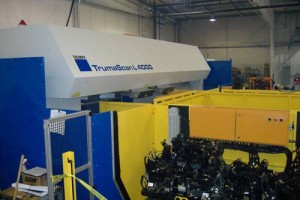Process: CO2 Remote Laser Welding
Industry: Automotive
Parts: Seating Components
Company: Tier-One Automotive Supplier
Project Results
Remote CO2 Laser welding system meets or exceeds project requirements for welding seat back components that includes tooling changeover for multiple assemblies. Remote CO2 laser system with quick-change tooling achieves and exceeds customer’s expectations.
Challenges
- Integrating remote CO2 laser welding system with real time weld monitoring with quick change tools to meet tough customer demands from various automotive company quality expectations
- Laser welding of these components requires a “no gap” condition between the parts to successfully weld
- This requires high quality tooling to consistently remove the gap while still providing dimensional stability
- A high level of flexibility was required to allow the cell to quickly change over and to run various models and assemblies
Tennessee Rand successfully engineered, fabricated, programmed, and installed this system at a Tier-One Automotive supplier in the US. Experience in laser welding was vital for this challenging project. With the laser beam being delivered from a TRUMPF Trumascan® 1.5 meters away and all the necessary tooling to hold the individual components in place for welding, Tennessee Rand’s tooling experts provided a tooling design that closed the gaps consistently and repeatedly with the added complexity of introducing a shield gas at every weld interface. These quick change tools not only had to be dimensionally repeatable, but also operator and maintenance friendly. These tools needed to be changed out quickly by disconnecting air, shielding gas, power and communication, removing the entire tool and replacing it with another tool to allow various assemblies to be manufactured on one cell.
The cell was equipped with a MOTION® four station dial indexer, TRUMPF Trumascan L4000 with 6 kW CO2 laser power source, and a PRECITEC LMW® weld monitor. The combination of Tennessee Rand experience and CNC-based machine shop made for a winning combination to integrate the various components for their customer. This combination of equipment resulted in the cell achieving welding speeds of approximately 7 meters per minute with 100% real time weld quality monitoring.
